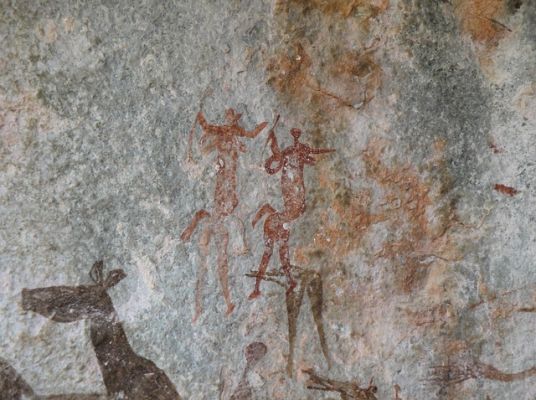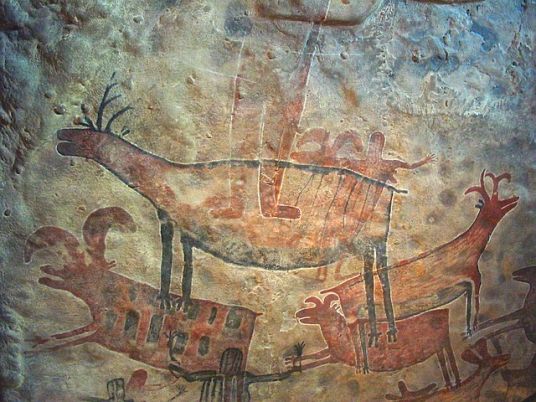Prehistoric Painting – Rock Painting, Concepts and Importance
Contents
What is Prehistoric Painting?
In prehistoric art, prehistoric painting is defined by the term “rock painting” which encompasses any rock art that consists of the application of colored pigments on the walls, floors or ceilings of ancient rock shelters. A monochromatic rock painting is an image made with only one color (usually black), for example, the monochromatic images at Chauvet.
A polychrome cave painting consists of two or more colors, exemplified in the multicolored images of bison on the ceiling of the Altamira cave, or the Uros in the room of the bulls at Lascaux. In contrast, the term “cave drawing” refers (strictly speaking) only to an engraved drawing, i.e., one of lines cut into the rock surface with a stone or flint tool, rather than one made by drawing lines with charcoal or manganese.
Definition of Prehistoric Painting
Most cave paintings were figurative and 99 percent of these were of animals. At first, Stone Age artists painted predatory animals (lions, rhinoceroses, saber-toothed cats, bears) almost as often as game animals such as bison and reindeer. However, the Solutrean period from images was dominated by hunting animals. Paintings of humans were very rare and were generally highly stylized and less naturalistic than animal figures.
Typically a polychrome rock painting was created in three basic stages, which can vary significantly depending on the experience and cultural maturity of the artist, the nature and contours of the rock surface, the strength and type of light and the raw material available. For example, in taking an image of a bison, first, the outline and basic features of the animal are drawn on the cave wall, marking the rock surface with a sharp stone, or applying a black outline with charcoal or manganese. Second, the finished plane of the animal would be colored or filled with red ochre or other pigments. Third, the edges of the animal’s body would be shaded with black or other pigment to increase its three-dimensionality. Moreover, depending on whether or not the contour of the cave wall became necessary, additional engraving or even sculpting would be applied to increase volume and relief.
How did Prehistoric Painting develop?
At present, prehistoric cave painting consists of abstract signs, i.e., a red dot and a hand print. These images have been dated to at least 39,000 B.C. and 35,500 B.C. respectively, being the oldest art of their type found in caves in Europe.
However, in 2014 in Indonesia, archaeologists found images in Timpuseng Leang cave, Sulawesi, from 37,900 BC. (Animal paintings). Then two Claviform symbols were found in Altamira, from 34,000 BC. The oldest paintings are those of the Chauvet cave, located in the region of Ardéche, France, which were discovered in 1994 and date back to 30,000 BC. Thus, the most productive periods of rock art were the Gravetian and Magdalenian cultures dating from 25,000-20,000 B.C. and 15,000-10,000 B.C. respectively.
Stone Age artists created a variety of figurative and abstract images. Naturalistic images mainly depict hunting scenes, or arrangements of animals, usually bison, horses, reindeer, cattle, Uros and mammoths, although they depicted a wide variety of other creatures, such as: lions, musk ox, saiga, chamois, wolf, fox, hare, otter, hyena, seals, fish, reptiles, birds and other creatures that also appear. But no landscape paintings have been found in prehistoric art, including no elements of the landscape depicted, such as mountains or rivers. Images of human beings appear very rarely, thus, they are human-like, rather than real humans. Some examples of these paintings are: the ‘wounded’ at Cougnac; the painting of the man with the bird’s head, the “shaft of the dead man” at Lascaux, and the engraved painting of the “sorcerer” in the cave of Trois-Freres.
As mentioned, abstract art is also common. Cave walls abound with a variety of dots, lines, signs and symbols. For example, researchers at the University of Victoria on Vancouver Island, Canada, have identified more than 20 signs, all painted in the same style, that appear over and over again in different shelters. Some of them are made with simple brush strokes, such as circles, semicircles, triangles and straight lines; others are a bit more complex. In addition to those mentioned only, they include: aviform, claviform, cordiform, striped, cruciform, flabeliform, negative hands, open angles, accompanying, pectiform, peniform, positive hands, quadrangles, scalar shapes, serpentiform, spirals, tectiform, zig-zags and other shapes.
Using seashells as paint vessels and working with firelight, or sometimes weak sunlight, prehistoric artists employed a variety of painting methods. Initially, they painted with their fingers, before moving on to colored pencils made of lump pigment, moss pads, or brushes made of hair or plant fiber. They also employed more sophisticated spray-painting techniques using specially hollowed reeds or bones, staining with red ochre, dating from around 16,000 BC, which were found in the cave of Altamira, revealing works by Solutrian and Magdalenian artists. Thus, Stone Age painters also used foreshortening and chiaroscuro techniques. Each era introduced new methods of painting caves decorated for many generations and exhibiting numerous styles, at Lascaux, for example.
What was the importance of prehistoric painting?
Initially, most paleoanthropologists thought that this type of ancient art was purely decorative. However, detailed archaeological evidence shows that painted caves were not inhabited by ordinary people. Instead, they were inhabited only by a small group of artists and others involved in ceremonial activities. As a result, it is now thought that cave painting was created by shamans for ceremonial reasons, perhaps in connection with social, supernatural or religious rituals. There is no clear pattern in the iconography used, so most current theories as to the precise meaning or function of Stone Age cave painting are mere conjecture.
What are the main representations of prehistoric painting?
Prehistoric painting is mostly represented in famous caves that contain them. Most of these caves are located in Europe (France and Spain). Some of them are described below:
Franco-Cantabrian cave cave rock paintings which is probably one of the most famous than any other wall art tradition in the world.
Cave of El Castillo (39,000 B.C.). Puente Viejo, Spain. Discovered in the Monte Castillo cave complex, this rock shelter contains the oldest art of any cave in Europe.
La Pasiega Cave (c.16,000 B.C.) El Castillo Caves, Cantabria, Spain. Discovered in 1911, La Pasiega cave consists of a main gallery, about 80 yards long, with openings for several secondary galleries. Its rock art consists of more than 700 painted images (approximately 100 deer, 80 horses, 30 ibex, 30 cattle, along with reindeer, mammoth, birds and fish) including numerous abstract symbols (idiomorphs) and engravings.
The Fúmame Cave (35,000 B.C.) in Italy. It is a prehistoric cave believed to have been inhabited by Aurignacian reindeer hunters, in which a number of cave paintings of primitive animals were found in fragments of a collapsed cave wall.
Abri Castanet (35,000 BC). Dordogne rock shelter containing engraved images of male and female genitalia, along with ochre paintings of horses and some abstract symbols.
Altamira Cave (first phase 34,000 B.C.). Antillana del Mar, Spain. A club-shaped symbol in the most remote part of the cave was U/Th from 34,000 BC. Discovered in 1879 and dating from 15,000 BC, Altamira is considered by archaeologists and art historians to be “the Sistine Chapel of Paleolithic art” because of its high quality large scale mural. The ceiling of its so-called polychrome room – decorated with 30 large pictures of animals (mostly bison) vividly executed in red and black pigment – is considered to be the artistic achievement of Magdalenian art in the Franche-Cantabria region. For more information, see: Altamira cave paintings.
The Chauvet Cave (30,000 B.C.) Vallon-Pont-d’Arc, France. Considered a showcase of Aurignacian art, discovered in 1994, it is composed of two main parts. In the first part, most of the paintings are in monochromatic red, while in the second part, the animals are mostly black. The most striking images are the group of horses and the panel of lions and rhinos.
The Cosquer Cave (25,000 BCE), off the coast of Marseille, France. Discovered by deep-sea diver Henri Cosquer in 1985 and dating to 25,000 BCE, the entrance to Cosquer Cave is more than 100 feet below sea level. Its paintings include stamped hands, poster-type signs, charcoal drawings, and nearly 100 polychrome paintings of horses and other animals.
The Pech-Merle Cave (25,000 BCE) Cabrerets, Midi-Pyrénées, France. Discovered in 1922, Pech-Merle is famous for prehistoric paintings of dramatic spotted horses, polychrome paintings, charcoal and ochre paintings on limestone and its poster-like signs.
Lascaux Cave (c.17,000-13,000 BC). Montignac, Dordogne, France. Discovered in 1940, Lascaux contains Solutrian and Magdalenian art. The cave complex has seven chambers decorated with over 2,000 painted images, including the impressive Hall of the Bulls which, despite its name, is characterized primarily by horses, as well as the male Uros (wild cattle) from which it derives its name. It contains renowned images such as the great black bull, the Unicorn and the bird man.


